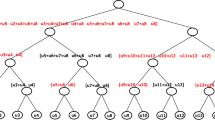Abstract
This paper presents the design and implementation of a low complexity and highly efficient configurable singular value decomposition (SVD) processor for 2 × 2, 4 × 4, 6 × 6, and 8 × 8 MIMO wireless communication systems. In order to minimize the area complexity while maintaining comparable throughput, novel data-processing sequences are proposed so that costly matrix multipliers are eliminated. Furthermore, data dependencies are greatly mitigated due to the proposed processing sequences. Therefore, a highly optimized pipelined architecture is designed where the resource utilization and hardware efficiency are significantly improved. Moreover, circuit level optimizations are also applied to further enhance the performance of the proposed SVD processor. The proposed SVD architecture has been implemented with 90 nm technology at 500 MHz clock frequency. The post-layout estimations show that the proposed SVD processor achieves a throughput of 1.1 M matrices/s for 8 × 8 MIMO communication systems with the hardware complexity of 192.2 kilo Gate Equivalents. Compared to the state-of-the-art design that supports 2 × 2, 4 × 4, 6 × 6, and 8 × 8 MIMO configurations, the proposed architecture demonstrates a 46% reduction in area complexity and a 22% improvement in hardware efficiency.








Similar content being viewed by others
References
C. Chae, A. Forenza, R.W. Heath, M.R. McKay, I.B. Collings, Adaptive MIMO transmission techniques for broadband wireless communication systems [Topics in Wireless Communications]. IEEE Commun. Mag. 48, 112–118 (2012). https://doi.org/10.1109/MCOM.2010.5458371
Y.-L. Chen, C.-Z. Zhan, T.-J. Jheng, A.-Y. Wu, Reconfigurable adaptive singular value decomposition engine design for high-throughput MIMO–OFDM systems. IEEE Trans. Very Large Scale Integr. Syst. 21, 747–760 (2012). https://doi.org/10.1109/TVLSI.2012.2195040
M. Garrido, P. Källström, M. Kumm, O. Gustafsson, CORDIC II: a new improved CORDIC algorithm. IEEE Trans. Circuits Syst. II Express Br. 63, 186–190 (2015). https://doi.org/10.1109/TCSII.2015.2483422
A. Ghosh, A. Maeder, M. Baker, D. Chandramouli, 5G evolution: a view on 5g cellular technology beyond 3GPP release 15. IEEE Access 7, 127639–127651 (2019). https://doi.org/10.1109/ACCESS.2019.2939938
A. Goldsmith, S.A. Jafar, N. Jindal, S. Vishwanath, Capacity limits of MIMO channels. IEEE J. Sel. Areas Commun. 21, 684–702 (2003). https://doi.org/10.1109/JSAC.2003.810294
D. Guenther, R. Leupers, G. Ascheid, A scalable, multimode SVD precoding ASIC based on the cyclic Jacobi method. IEEE Trans Circuits Syst. I Regul. Pap. 63, 1283–1294 (2016). https://doi.org/10.1109/TCSI.2016.2561904
H. Huang, L. Xiao, J. Liu, CORDIC-based unified architectures for computation of DCT/IDCT/DST/IDST. Circuits Syst. Signal Process. 33, 799–814 (2014). https://doi.org/10.1007/s00034-013-9661-9
Y.-T. Hwang, K.-T. Chen, C.-K. Wu, A high throughput unified SVD/QRD precoder design for MIMO OFDM systems, in 2015 IEEE International Conference on Digital Signal Processing (DSP), IEEE, 2015, pp. 1148–1151. https://doi.org/10.1109/ICDSP.2015.7252059
D.J. Love, R.W. Heath, V.K. Lau, D. Gesbert, B.D. Rao, M. Andrews, An overview of limited feedback in wireless communication systems. IEEE J. Sel. Areas Commun. 26, 1341–1365 (2008). https://doi.org/10.1109/JSAC.2008.081002
P.K. Meher, J. Valls, T.-B. Juang, K. Sridharan, K. Maharatna, 50 years of CORDIC: algorithms, architectures, and applications. IEEE Trans. Circuits Syst. I Regul. Pap. 56, 1893–1907 (2009). https://doi.org/10.1109/TCSI.2009.2025803
S. Mopuri, A. Acharyya, Configurable rotation matrix of hyperbolic CORDIC for any logarithm and its inverse computation. Signal Process. Circuits Syst. (2019). https://doi.org/10.1007/s00034-019-01277-w
A.J. Paulraj, D.A. Gore, R.U. Nabar, H. Bolcskei, An overview of MIMO communications-a key to gigabit wireless. Proc. IEEE 92, 198–218 (2004). https://doi.org/10.1109/JPROC.2003.821915
C. Senning, C. Studer, P. Luethi, W. Fichtner, Hardware-efficient steering matrix computation architecture for MIMO communication systems, in 2008 IEEE International Symposium on Circuits and Systems, IEEE, 2008, pp. 304–307. https://doi.org/10.1109/ISCAS.2008.4541415.
R. Shukla, K.C. Ray, Low latency hybrid CORDIC algorithm. IEEE Trans. Comput. 63, 3066–3078 (2013). https://doi.org/10.1109/TC.2013.173
G.L. Stuber, J.R. Barry, S.W. Mclaughlin, Y. Li, M.A. Ingram, T.G. Pratt, Broadband MIMO-OFDM wireless communications. Proc. IEEE 92, 271–294 (2004). https://doi.org/10.1109/JPROC.2003.821912
C. Studer, P. Blosch, P. Friedli, A. Burg, Matrix decomposition architecture for MIMO systems: design and implementation trade-offs, in 2007 Conference Record of the 41st Asilomar Conference on Signals, Systems and Computers, IEEE, 2007, pp. 1986–1990. https://doi.org/10.1109/ACSSC.2007.4487584.
B. Tiwari, N. Goel, Implementation of a fast hybrid CORDIC architecture, in 2016 Second International Conference on Computational Intelligence and Communication Technology (CICT), IEEE, 2016, pp. 702–706. https://doi.org/10.1109/CICT.2016.145.
M. Vu, A. Paulraj, MIMO wireless linear precoding. IEEE Signal Process. Mag. 24, 86–105 (2007). https://doi.org/10.1109/MSP.2007.904811
C.-H. Yang, C.-W. Chou, C.-S. Hsu, C.-E. Chen, A systolic array based GTD processor with a parallel algorithm. IEEE Trans. Circuits Syst. I Regul. Pap. 62, 1099–1108 (2015). https://doi.org/10.1109/TCSI.2015.2388831
C.-Z. Zhan, Y.-L. Chen, A.-Y. Wu, Iterative superlinear-convergence SVD beamforming algorithm and VLSI architecture for MIMO-OFDM systems. IEEE Trans. Signal Process. 60, 3264–3277 (2012). https://doi.org/10.1109/TSP.2012.2190405
Author information
Authors and Affiliations
Corresponding author
Additional information
Publisher's Note
Springer Nature remains neutral with regard to jurisdictional claims in published maps and institutional affiliations.
Rights and permissions
About this article
Cite this article
Chen, WJ., Lai, YA. & Shen, CA. The VLSI Architecture and Implementation of a Low Complexity and Highly Efficient Configurable SVD Processor for MIMO Communication Systems. Circuits Syst Signal Process 39, 6231–6246 (2020). https://doi.org/10.1007/s00034-020-01458-y
Received:
Revised:
Accepted:
Published:
Issue Date:
DOI: https://doi.org/10.1007/s00034-020-01458-y




